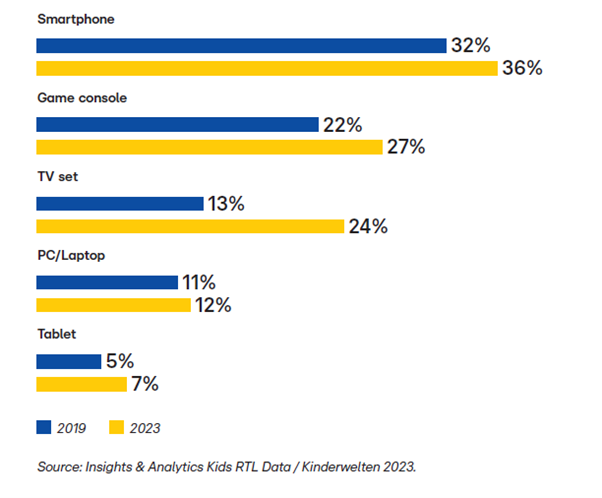Today, children have access to media as a matter of course. Television and digital video content have much more positive connotations than in the past, when people were still arguing about the dangers of Teletubbies.
Over the last twelve years, the time children spend watching linear television has more than halved – from 93 to 37 minutes. Compared with 2010, they spent 60% less time on linear TV in 2022. TV use no longer differs according to the age of the child. Toddlers (three to five years) watched 36 minutes, elementary school children (six to nine years) 39 minutes and the older ones (10 to 13 years) a total of 36 minutes a day.[1]
Children are switching from linear TV to other platforms. We asked parents about the use of these platforms, but it is difficult for the respondents to give an estimate of time spent on these and it is only ever a query at a specific point in time, so it is not comparable with continuous measurement.
In the fall of 2022, the KIM study[2] surveyed the usage times of six to 13-year-olds via an assessment by their parents. The study results indicate 43 minutes of internet use (all types of content, not just videos), 31 minutes of streaming and 16 minutes each for the TV stations’ media libraries and YouTube channels.
Increased media consumption goes hand in hand with an increased range of content and a wide variety of genres. However, children encounter much more content on these platforms that is not made or intended for them. Children need to become more resilient in their media use – especially when it comes to social media. Their media skills are often not yet sufficient to process the content they see or the posts they receive.
The move away from children’s television on linear TV and towards other non-linear, digital offerings is made possible by their access to smartphones, laptops or tablets. Mobile devices enable children to consume content in places beyond the home for example, in waiting situations, together with friends or on the move.
As a rule, the devices do not belong to the children themselves, but an agreement is reached within the family as to who may use which device. Independent use becomes possible for children when they own a smartphone themselves. 51% of six to 13-year-olds own a smartphone and 42% would like to (KINDER MEDIEN MONITOR 2023).[3] Having their own device opens up the possibility of participating in the media world in a more self-determined and less regimented way.
Among kids aged between 6 to 13, 51% own a smartphone and 42% would like to.
How involved are parents in their children’s media choices? At what age do they let children decide?
Parents involve their children early on in deciding what content to watch. They trust the providers of children’s TV and allow children to choose something from what is on offer. Parental regulation only takes place in terms of time, no longer in terms of content.
Parents of young children are more likely to specify content because they don’t want their children to see anything problematic. Forty-six percent of parents of children aged six to 13 years say that the child is allowed to decide which TV shows to watch. [4] When the children get older, around the age of eight or nine, parents realise that they have to have new discussions about what is suitable.
These topics are very challenging for families. Parents need to educate children on privacy settings, data protection, bullying, problematic content, fake news, influencer marketing and much more. Many parents are overwhelmed by this and say in studies that they simply hope that nothing bad will happen.
What can you tell us about kids and gaming?
Children have always enjoyed playing electronic games and games are an integral part of SUPER RTL’s digital TOGGO platforms. Games are a part of children’s everyday lives, with 58% of children aged three to 13 playing electronic games, often together with their parents.[5]
The pandemic provided a particular boost, especially for multiplayer online games as children discovered the possibility of interacting with friends or other gamers. However, there are risks that few parents are aware of. Children often try “Let’s Play” videos on YouTube, which introduce them to games that they may not yet be allowed to play themselves.
What advice would you give to broadcasters so that they do not to lose children to Netflix?
Broadcasters should curate children’s programming in linear and non-linear formats. Of course, the priority should be on platforms designed specifically for children (in a safe environment).
In addition to its linear offering, TOGGO, for example, also hosts much-used YouTube channels and a kids’ media library. Here, the content is edited and selected. This means that children and parents can be sure that only age-appropriate content is shown on these channels.
Broadcasters that specifically target children offer a wide variety of genres, including animated series, magazines, quiz shows and more. The editorial offering is supplemented by modern content types in the form of clips and shorts and sometimes rounded off with games.
It is advisable to also provide local content that is tailored to the needs of children living in their respective countries. Streaming services can rarely do this comprehensively. Local content is often well received by children and is also desired by parents.
Free services for children and families remain a good alternative to Netflix and the like.
Broadcasters should curate children’s programming in linear and non-linear formats. Of course, the priority should be on platforms designed specifically for children (in a safe environment).
Linear television is the medium that all children are allowed to use and is firmly anchored in children’s everyday lives. Even if the duration of use has fallen, television is still the basic medium through which advertisers can reach their target group in a way that is easy to plan.
In addition, children use the online offerings of children’s programmes, and older ones also use YouTube. Many broadcasters have responded to this usage behaviour and curate content on these platforms as well. For advertisers, this offers the opportunity to advertise in a brand safe way across different platforms.
Device ownership among children aged 3-13 years
And which of these devices that exist in your home belong to your child personally?

What linear TV content currently works well with German children?
Boys prefer to watch series from the adventure cartoon category (for example: Miraculous, Paw Patrol), slapstick cartoons (for example: SpongeBob SquarePants) and anime (for example: Pokémon).
Girls are also enthusiastic about adventure cartoons, but also like live-action series such as Die Pfefferkörner and Schloss Einstein. These live action series serve as an orientation for girls about their lives and about topics that still await them.
Older children and young people also watch adult formats such as The Simpsons, Big Bang Theory, casting shows (e.g. Germany’s Next Top model), daily soaps or special series from the streaming world.
Do the viewing habits of German children differ from children in other countries?
I don’t think children are different from one another per se, but Germany has a few special features when it comes to children’s TV. One specialty is Sunday mornings, when families specifically turn on the TV to watch Die Sendung mit der Maus (The show with the mouse), which focuses on educational content.
Knowledge formats also play an important role in German children’s television. As a provider, you have to serve the genre because it has an important effect on the broadcaster’s image – even if the demand from children is often not that great. Another special feature in Germany is the long-running success of Weihnachtsmann & Co. KG (The Secret World of Santa Claus), a German phenomenon each Advent season.
Are there any further studies on children and media that you would recommend?
Based on qualitative interviews, Ofcom’s report describes children’s media use in the UK and looks at how children play, are entertained and communicate. It also describes the problematic aspects of media consumption. [6]
For more than 20 years, SUPER RTL and the AdAlliance have been sharing insights on children’s media consumption and derivations for commercial communication and engaging in discussions with market partners. Articles and presentations are produced as part of the annual Kinderwelten conference and can be accessed here.




















